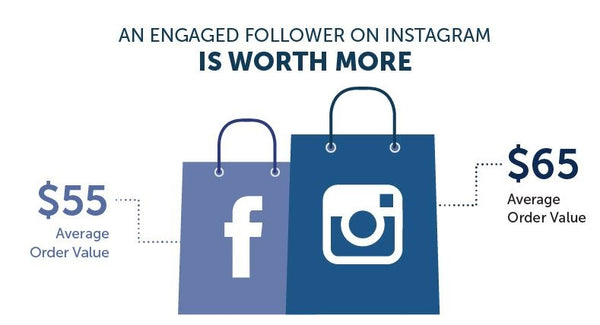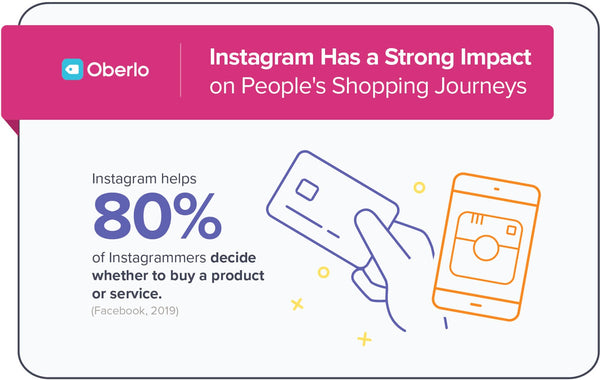More than 72% of internet users admit searching for visual content before making a purchase. The survey also found that 78% of online shoppers said they want more images on eCommerce sites. The two statistics are proof of why Instagram has become a leading channel for businesses to promote their products.
But with so many businesses starting their online store and trying to tap into this consumer behaviour, the competition for attention has grown by manifolds. It’s not just becoming harder for businesses to reach more customers, but they’re also struggling to cope with the pressure of optimizing their profiles with the right content, information and hashtags that promote their product.
In this article, we’re sharing everything you need to know about Instagram marketing to grow your Shopify store.
But before we dive into how you can optimize your store’s Instagram page, let’s take a quick look at why you should be selling on Instagram.
Selling on Instagram. But why?
More product pictures. More concept shoots. More visual content. More creativity. Why should a Shopify store really spend so much time on one platform to reach their customers, especially when there are so many other channels they could be used to sell products online?
Here are some reasons why we think Instagram marketing is a must for Shopify stores of all sizes.
1. Instagram’s format is the best for showcasing your products
Because of its visual nature, Instagram offers a great platform to online brands that are seeking to showcase their products. Be it through regular product photos or videos from product shoots or even Instagram stories, businesses across the globe know the importance of ‘visuals’ for selling products online.
Irrespective of their industry, they know that presenting their products visually makes a positive impact on their other marketing and advertising efforts.
2. Instagram users are more engaged
About 40% of internet users respond to visual content better. That’s why Instagram users have been proven to be far more engaged than those on other social media platforms - including Facebook and Twitter.
Despite the increasing competition on the platform, keeping into account the time when your audience is the most active and using the right hashtags can get you more engagement on your posts. We’ll be covering more on this in the coming sections.

3. Instagram users are more likely to make purchases
According to a recent study, about 72% of Instagram users make a purchase decision right after seeing something on Instagram. This is because they’re able to instantly see if the product is trending (based on the likes and comments on a post), and also user-generated content from others who have purchased it already. The most popular categories that see this purchase behaviour include fashion and apparel, makeup, shoes, jewellery and packaged foods.
Also read: The changing consumer behaviour and how fashion and apparel brands can survive COVID-19
4. Instagram equips your business with interactive tools
From what started as a simple platform to share images as posts, Instagram today has equipped online businesses with a number of interactive tools. Right from carousel posts to Instagram stories, video posts, IGTV and shoppable Instagram posts, there are so many ways for your Shopify store to sell on Instagram.
Simply put, Instagram equips you with visually-driven tools to reach, engage and convert high-intent buyers into customers.
But just like any other channel, to make Instagram marketing work for you, you need to focus on turning your profile into a sales engine. Just uploading great pictures of your products is not enough!
Optimizing your Shopify store Instagram page to sell products online
Step 1: Add your brand logo as a profile picture
First things first. Start optimizing your Instagram page from your profile picture. This place is not meant for random icons, personal pictures or stock photos. You need to add a logo for your brand here so that Instagram users know this is a ‘brand page’ and not a personal profile.
It is also something that reinforces your brand in the shopper’s mind every time they visit your feed. So make sure your account looks real and authentic with a logo added here. Remember to resize the logo to make sure it doesn’t get cropped from any end.

If you don’t have a logo yet, get one for FREE using Hatchful by Shopify - read the complete guide!
Step 2: Make your Instagram bio impressing
Your Instagram bio makes or breaks the impression you make on a shopper. Typically, an Instagram user would come across your post while browsing through their feed or searching for a specific hashtag. The very next step for them is to check out your profile before they click through to your store site.
So make sure your Instagram bio clearly states what your brand is all about. You can also use this space to share a little about how your products are made or your vision and mission. Adding a few emojis and trending hashtags in your Instagram bio can go a long way too!
For example, here’s Bareek using their Instagram bio to share what their brand is all about.

Step 3: Include the right link in your Instagram bio
Instagram doesn’t let you add links to every post. But you can add one in your Instagram bio. To make the most of this, make sure the link you add takes the shopper directly to a page where they are the most likely to convert.
For instance, if you have been promoting a 50% sale site-wide in your posts, add a link to your ‘sale’ page. Similarly, if you’re promoting a new collection that you’ve launched, use the space to link the interested shoppers to it.
You can keep changing this link based on your Instagram marketing strategy to promote products and discounts.
For example, Whatif Drinks always keeps its Instagram bio link updated to the product they’re promoting.

Pro tip: If you’re running marketing campaigns on different channels, make sure that you add a trackable URL in the bio. This will help you identify where your traffic is coming from and if your Instagram efforts are really paying off. You can simply use the Google URL Builder for this.
Step 4: Identify the top-searched hashtags
Before you start posting content on your Instagram feed, make sure you have a list of hashtags that can help you get discovered. Identify the industry that your products fall under, then look for hashtags that Instagram users are commonly making use of in their posts. Don’t forget to take a look at the Instagram hashtags similar businesses are using in their posts - it’s a great way to start.
You can also use the Keyword Tool to find the best and trending hashtags on Instagram. Simply type in a keyword that best describes what your store is selling and it lists down all the hashtags along with the number of posts made using them. You can also filter these hashtags based on parameters like ‘new’ to check what’s the latest trend.

You’re allowed to use upto 30 Instagram hashtags in a post. So make the most of this opportunity to reach your audience!
Growth hack for Instagram marketing: You can also post Instagram hashtags in your post comments. After every few hours, you can delete the comment and post the same or new hashtags again. This will help you reach more Instagram users - those who you weren’t able to reach when you posted first.
Find the best Instagram hashtags for your post: Remember to identify what’s trending in your target market. Take a look at the kind of content your ideal customers are engaging with and create posts that don’t just join them, but also promote your product doing so.
For example, we all know of the Banana Challenge. So if your Shopify store is selling sunglasses, why not create an interesting post around it?
Step 5: Create a theme for your Instagram feed
There’s too much competition on Instagram. Visually-appealing no longer means just high-quality product pictures and videos. The aesthetics with which you post these matter too in grabbing the attention of Instagram users and nudging them towards making a purchase from your store.
Simply put, the better your Instagram feed looks, the more engagement you’ll have on your page.
A lot of people think creating an Instagram feed is all about being restricted to the colours you use in your pictures. But that’s not true! You can turn your Instagram feed to look bright and full of colours, or go for something minimal instead - the choice is always yours.
The idea is to be able to set a tone for your brand that your followers can resonate you with. Using your brand colours is a great way to improve brand recall in the long run.
Here’s an example from Blue Dahlia. They’re using a simple theme for all their posts to keep the look and feel consistent.

Think editing pictures is too complicated? You consider buying a preset that matches the look and feel you want from Shopify stores like 123Presets. They have ready-to-use presets for easy photo editing in every style!
Step 6: Create an Instagram content calendar
A lot of Shopify stores invest time in conceptualising their product shoots. But what they don’t focus on is creating a calendar for their Instagram page to keep things consistent, and to track what’s working for them (or not).
To start creating a calendar, look into your Instagram page insights. Identify the days and times that have worked well for you - in terms of reach, engagement and the actions taken on your page. If you’re just starting off with Instagram, a good idea is to follow the day and time suggested by Later.
The next step is to identify the types of content that your audience likes the most and has improved your engagement rate. Then create a simple social media calendar for your Instagram page that includes the caption, post types (single image, video, carousel, IGTV, GIF), days and time at which you want to make the post and the link you will add to your Instagram bio when posting this content. Try and create a 3-week plan in advance to avoid the last-minute rush!
You don’t need to make a post every day. Just find a consistent pace at which you can keep your audience engaged. And while you’re doing so, make sure your content calendar includes different formats of content because not everyone just likes the usual image posts. Different strokes for different folks!
Here are a few content formats you should definitely include in your Instagram marketing content calendar:
1. Instagram feed content
- Q&A
- Sneak Peak
- How to photos & videos
- Behind the scenes
- Product recommendations Advice
- Motivation
- Giveaway
- Influencer Takeover
- Promote new products or services
2. Instagram Live Videos
3. IGTV (Instagram TV)
4. Instagram Stories
If you’re not sure how to create an Instagram marketing content calendar, download this FREE template from HubSpot.
Step 7: Make your Instagram feed shoppable
About 80% of Instagram users decide on making a purchase based on what they see on the platform. The numbers suggest that for a lot of consumers, the shopping journey begins on Instagram. Now typically, a shopper would discover a product on Instagram and then go on to visit the store’s site to make a purchase. But what if you could make it simpler?

You can turn your Shopify store’s Instagram feed shoppable with Shoppable Instagram. This lets you tag products on your Instagram feed posts or even your Instagram stories. This makes it easier for the shoppers who discover your brand on Instagram, to tap on the post and buy it directly from Instagram.
With a shoppable Instagram feed, you can reduce the number of steps a shopper needs to take to make a purchase. The more seamless and comfortable the journey, the more likely they are to make the purchase.

Step 8: Analyze your performance to optimize day and time for posts
Whether you’re promoting your Instagram posts with paid campaigns or trying to boost engagement with organic tactics, keep a close watch on the performance. Look into Instagram Insights to see which day and time of posting gets you the most amount of reach, engagement and activity on your Instagram bio link.
Step 9: Promote your best performing posts
Next step is to identify your best performing posts and promote them using paid campaigns. This is a foolproof way of getting your target audience to engage with your brand and even lead them to taking a desired action on your store - for instance, creating a wishlist, signing up for your newsletter to get deals and discounts or even adding the product they liked so much on Instagram to their cart to get an exclusive 10% discount.
It’s like knowing what online shoppers really like about your brand and then using it to drive more traffic and conversions on your store.
Here's an example of an Instagram ad Fabuliv is running:

Also read: The beginner’s guide to advertising on Instagram
Now a step that a lot of Shopify stores don’t include in their Instagram marketing strategies, losing out on engagement as well as conversions.
Need help setting up Instagram ads? Get a FREE ad consultation from Spin by RevTap.
Step 10: Display your Instagram feed on your store
When you’re doing so much to optimize your Instagram bio to impress, create a feed that engages your audience, why not use it on your store as well to keep this engaged Instagram user as involved with what your brand has to share even when they reach your site?
By embedding your Instagram feed on your home page, product page or even the blog, you give the visitor additional content to engage with. That too on a platform and in a format they love engaging with!
Displaying your beautifully curated Instagram feed, you can reinforce the same brand story you shared on the platform. You can also share customer testimonials and user-generated content to show how loved your products are.
You can do this easily by using apps like InstaPics. Here’s how designer Simran Rihal uses her Instagram feed on her Shopify store to share more about her and the brand’s story.

Get more sales with Instagram marketing
Following the above steps is sure to help you build your brand on Instagram, reach more of your target audience and also drive engagement on your posts. But for your Instagram marketing efforts to really start paying off and driving sales, you need to go beyond using the best hashtags for Instagram, changing your Instagram bio and working on your Instagram captions.
You need to continually test different ways to keep your audience engaged on all those fronts and measure the impact every little experiment makes on your brand.
The idea is to stand out and grab attention from these shoppers. Not blend in by simply following what other brands are doing.
Here are a few Instagram marketing best practices you should keep in mind:
- Remain consistent with your Instagram content calendar
- Frequently change the best hashtags for Instagram posts
- Tap into trending hashtags on Instagram whenever possible
- Change your Instagram bio link at the same time as your promotions
- Use your Instagram post captions to tell a story or about the product (and not just its price)
- Interact with the shoppers that engage with your posts
- Use Instagram stories to announce your new post (just incase someone misses it)
- Nudge your followers to switch on notifications for your post (you don’t want them to miss out on your products)
- Continually track the performance of your posts to optimize your calendar for maximum impact
In a consumer market that is visually-driven, Instagram offers you a way to reach out and engage the audience with what they want to see. So make sure you know who your customers are and what they like before you start publishing content on your Instagram page.
